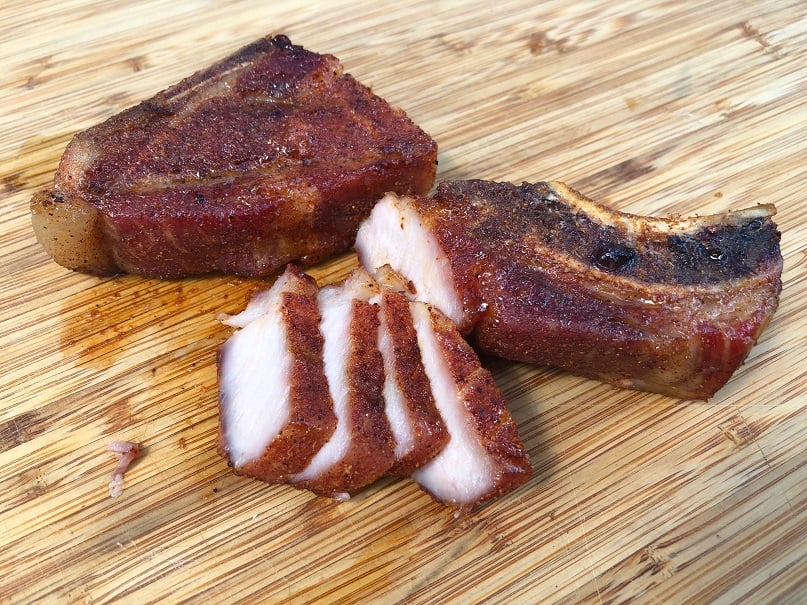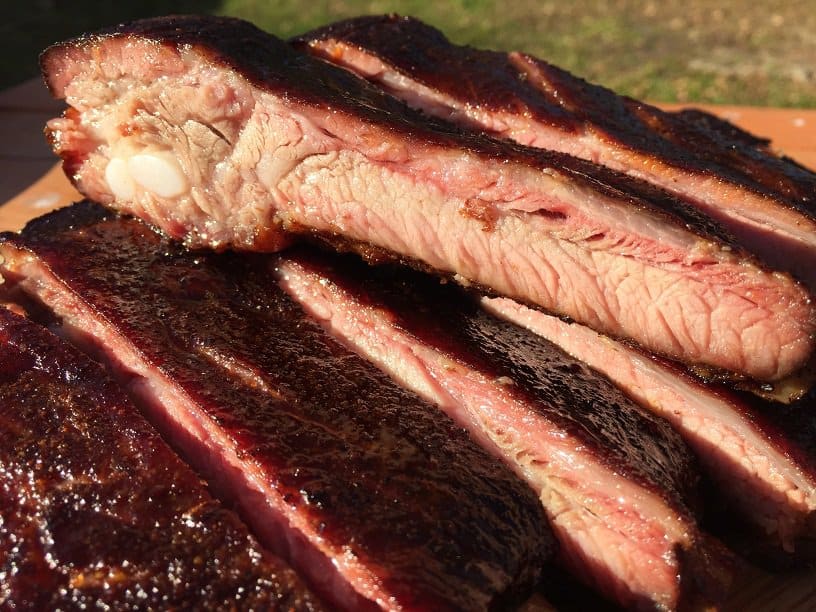Here is a handy internal temperature guide for cooking pork ribs that I hope you find useful! One of the reasons that cooking pork ribs can be confusing is that there are several different types of ribs along with different ways that people like to prepare them.
This guide will walk you through the most popular types of pork ribs as well as different preparation methods.

| Type of Pork Rib | Minimum Safe Internal Temp | Temperature to Wrap | Finished Temperature |
|---|---|---|---|
| Country Style Ribs | 145F, 63C | No Wrap Needed | 145F, 63C |
| Baby Back Ribs | 145F, 63C | 160F, 71C | 195F, 90.5C |
| St Louis Style Ribs | 145F, 63C | 160F, 71C | 200F, 93.3C |
| Spare Ribs | 145F, 63C | 160F, 71C | 205F, 96.1C |
“Ready to Eat” vs “Safe to Eat”
Pork is considered Safe to Eat after it reaches a minimum internal temperature of 145F. However, just because the meat is Safe to Eat does not always mean that the pork ribs are done and ready to eat.
In fact, in most cases pork ribs need to be cooked way past the Safe to Eat temperature to become tender.
The Ready to Eat temperature varies from 145F to 205F depending upon the type of pork ribs you are cooking.
Country Style Pork Ribs Temperature Guidelines
Country style pork ribs are cut from the Boston Butt (shoulder) section of the hog and sometimes, but not always, has a bone running through it. Although these are not a “true” pork ribs I am including them in this guide because they confuse a lot of people.
Country Style Ribs are more like a bone-in pork chop than a baby back rib. This style of rib is best cooked to exactly 145F when it is still tender and juicy.
There are some recipes that use country style ribs to make something like pulled pork which would require a finishing temperature of around 200F. Personally I like to cook these like pork chops instead of pulled pork because it is easy for the smaller bone fragments of a country style rib to get lost in the shredded meat.
See Pellet Grill Smoked Country Style Ribs for a great recipe!

Baby Back Ribs Temperature Guidelines
Baby back ribs are delicious, meaty and fun to cook. There are two temperatures to keep in mind when you are smoking baby backs:
- When to wrap them.
- When they are done.
A very popular technique for smoking baby back ribs is the 2-2-1 Method. This method has you wrap the ribs in an aluminum foil pouch after smoking for two hours. When people wrap the ribs varies with some people going by time, others by the color of the ribs and others going by the internal temperature of the meat.
If you are going by internal temperature then you will want to wrap the ribs when they hit the 160F mark and enter the “stall” phase of the cook.
Regardless of whether you decide to wrap them or not, baby back ribs are usually done when they hit an internal temperature of 195F. At this internal temperature the ribs are extremely tender and the meat will pull cleanly away from the bone.

Spare Ribs Temperature Guidelines
The temperature guidelines for spare ribs are a little different than for baby back ribs.
Just like baby backs, if you want to wrap spare ribs then you do it when they hit an internal temperature of around 160F.
The finished temperature for spare ribs is usually about 205F which is 10 degrees hotter than baby backs.
The reason you need to cook spare ribs to a higher temperature than baby backs is that spare ribs:
- Have more connective tissue that needs to render
- Includes a breast plate with extra cartilage and fat.
Or, put another way, spare ribs are a larger, tough piece of meat than baby backs and it takes a little longer to get them tender.

St Louis Style Ribs Temperature Guidelines
St Louis style pork ribs fall in between spare ribs and baby back ribs.
The St Louis cut starts with a slab of spare ribs and cuts off the breast bone. This trimming technique makes the St Louis style ribs easier to cook than spare ribs since you don’t have the massive breast bone to deal with.
Even though the breast bone gets removed there is still a lot of connective tissue down by the rib bones so the final internal temperature still needs to be a few degrees hotter than baby backs (200F vs 195F).
Temperature Measuring Tips
It can be tricky to monitor the internal temperature of ribs and you need to couple your measurements with common sense.
When you are measuring the internal temperature make sure that you are using an instant read digital thermometer and that the tip of the probe is in the meat and not resting on a bone. The easiest way to make sure you are getting a correct measurement is to slide the probe horizontally into the meat so the probe is going in the same direction as the rib bone. This is much more reliable than jabbing the meat from the top.
You should not rely totally upon internal temperatures when cooking ribs. In addition to temperature you should be:
- Watching for the meat to pull away from the bone.
- Feeling for the thermometer to easily slide through the meat.
- Picking up the ribs with your tongs to see how easily they bend.
By combining proper temperature measurement techniques with secondary observations of bone pull back and tenderness you will soon become a rib master!
Other Rib Posts You Might Like!
Here are some other posts about cooking ribs that I think you will like:


